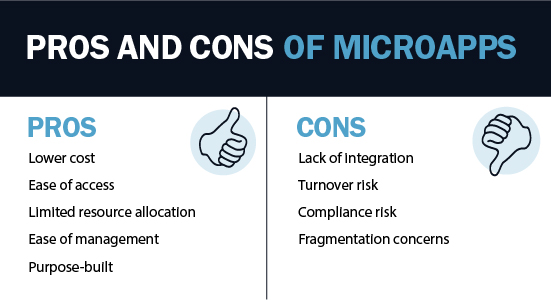Are Microapps Right For Your Organization?

While technology has proven time and again to be an aid to the healthcare space, it is possible to have too much of a good thing. Investing in a multi-use software tool that streamlines dozens of tasks has its merits, but sometimes, especially in smaller organizations, lack of use cases becomes a serious financial problem.
You wouldn’t use industrial strength adhesive to wrap a Christmas present when a little clear tape will do the trick, so why invest in a full software package to assist solely with something simple like patient document submission?
Enter micro-applications, or microapps, a more palatable solution for healthcare finance professionals who may not have the necessary time, attention and resources for a massive IT solution. Is a microapp-based strategy a viable short-term solution for improving your organization’s efficiency?

What is a microapp?
In a broad context, a microapp is a small, software-based solution designed to address one specific problem or
use case.
Microapps can be free or paid. Facebook Messenger is an example of a free microapp designed specifically to allow Facebook users to message each other and communicate with Business Pages. Hangouts is Google’s similar microapp designed only for chat-based communication between Google users.
Paid microapps usually follow a tiered pricing model with a basic version of the software available for free use. For example, HubSpot’s Customer Relationship Management tool is free to use with limited features, but paying more money brings more enhancements on top of the free-use features. Same with applications such as Mailchimp, Vimeo and Slack.
How are microapps used in healthcare?
The current landscape of microapps in the healthcare space is fairly limited. Most of the microapps are provided by non-profit organizations, governmental agencies and payers. These applications focus on problems such as program screening, payment estimation and auxiliary functions.
In terms of specific examples, Kaiser has many individual tools that can be considered microapps. Even a payor document submission portal can be considered a microapp as it is designed specifically to accomplish one job in
one use.
The healthcare IT vendor community has been slow to embrace the microapp model as solution providers tend to focus on providing larger tools that do more. This focus is clearly due to the hospital mantra that we have all heard many times, “one system, one platform, no auxiliary projects.” We agree with this in-concept, however, it is clear that (when done correctly!) there is a place in the industry for purpose-built microapps.
Why use a microapp?
Think of full-service healthcare software packages like a Swiss Army Knife. There’s a tool for every task you need completed all in one neat little gadget. But a microapp is a flathead screwdriver, robust and designed for one job only. It’s possible to invest in a Swiss Army Knife to place a screw, but it’s more money only to use a small screwdriver attached to a bevy of other tools. The one-job flathead screwdriver would serve you much better in this particular use case.
Big solutions are for big problems – they require big commitments, significant investments, and buy-in from several team members. But sometimes being business savvy means recognizing when a problem is small and needs a small solution, like a microapp.
Larger organizations may need to use a microapp’s features multiple times per day across hundreds of users. In this case, it makes sense to invest in a higher price tier. But smaller organizations may only need to use an app’s functionality 1-3 times per month, or even less. In this case, it makes sense to stick with base-level free or low cost options.
Translated into the healthcare space, large healthcare systems with thousands of employees and moving pieces often need to invest in complex IT systems to streamline operations. But using microapps provide an alternate model for solving specific problems within the healthcare revenue cycle at a lower cost.
Pros and cons of microapps
Like every solution, microapps have their good points and sticking points. Your business’s final decision simply depends on whether the pros outweigh the cons.

There are several pros to cultivating an arsenal of microapps as day-to-day tools, including:
- Lower cost – A small, free or low-cost solution saves money and increases ROI.
- Ease of access – Remember, small problems sometimes need small solutions. It’s easy to create an account and use a free tool as opposed to gathering the full team to make the decision on investing in a full healthcare software package.
- Limited resource allocation – Microapps can be used without taxing resources like labor and capital.
- Ease of management – One small tool is easily managed when compared to a large software solution.
- Purpose-built – Like the flathead screwdriver, microapps are built to excel at one objective only, making them, quite literally, the perfect tool for the job.
However, despite the multitude of good points, using microapps is not a perfect solution for every organization. Microapps come with several cons, including:
- Lack of integration – Microapps are not customizable, nor are they designed with your organization in mind. It can be frustrating to use a solution that isn’t integrated into your current software platforms.
- Turnover risk – If one employee had access to all microapps in use, and something happens to their position, suddenly the rest of the team may be locked out of microapps or worse, not know which tools were being used in the first place.
- Compliance risk – Not all microapps were built with HIPAA or healthcare compliance in mind. It’s important to be extra vigilant when using a generic solution capable of working across industries where privacy is not as big a concern.
- Fragmentation concerns – Unless employees communicate extensively, they may not know who is working in one app vs. another or understand the process. Without regulation, your organization risks fragmentation and mismanagement.
When to move beyond microapps
It’s fully possible to use an army of free or low-cost microapps to make your job easier without investing in a software solution. Think of the applications on your cell phone. You have probably created a portfolio of microapps that you open in specific cases. All these apps function independently, and you did not invest time, effort or money in gathering the tools you need for everyday life. The same is possible in a professional healthcare finance setting.
However, microapps tend to work best in smaller organizations with fewer audits, patients and activity. Larger organizations or those on the rise may find microapps chaotic with few benefits. At what point is it time to leave microapps behind and invest in larger, multi-purpose, all-in-one tools?
If you’re seeing fragmentation, process breakdowns or a lack of communication amongst team members, your organization probably has a bigger need for software to keep employees pointed in the right direction.
Microapps are also a simple solution designed to address a simple problem. If you find yourself facing multiple challenges within a process, that is likely the point at which you want to look into a system-wide approach to improvement rather than finding one solution for each challenge.
A one-off problem you encounter every few weeks or months calls for a microapp first. But a problem or process core to your job needs a bigger investment as you must rely on it weekly, even daily. Small solutions make your bottom line appear healthy, but always work smarter, not harder, and invest in a big solution when your problems outgrow what microapps can provide.
Are microapps right for your organization? At Bluemark, we hope to have some exciting products in this space launching in 2021. Stay tuned, and please contact us with any questions about microapps vs. large-scale technology-based solutions in the healthcare space.




